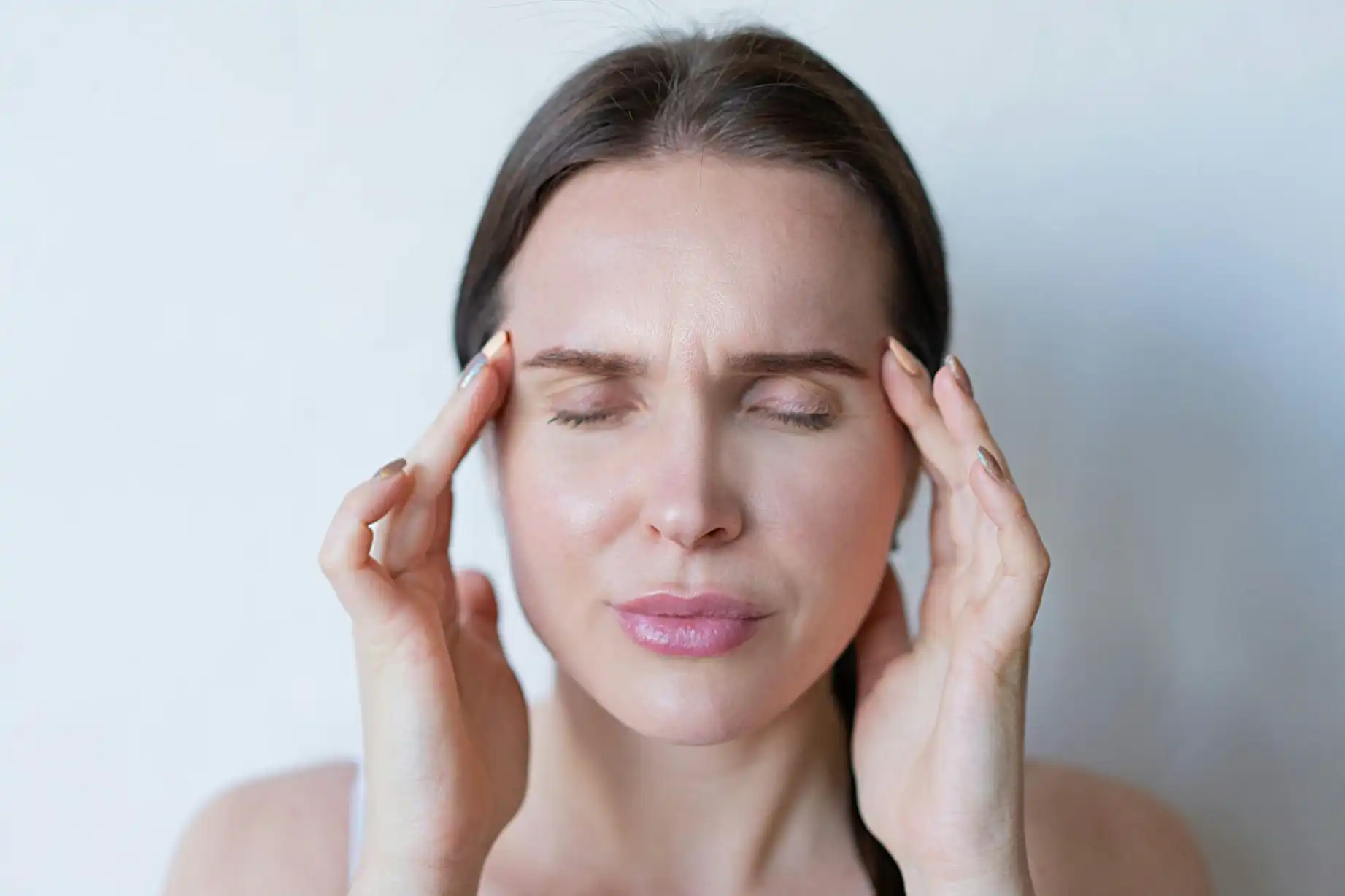
Last updated: 05-08-2024
Migraines are incredibly common, affecting between 15% and 23% of the UK population - while most well-known for the debilitating headaches the condition causes, there are other effects too. A migraine attack will also often include nausea and sensitivity to light and sound.
Women are much more likely to suffer from migraines than men, which could be potentially due to the effect of hormones. People are most likely to develop migraines when they are an adolescent or young adult, but children as young as toddlers can also be affected.
It’s not fully understood exactly what causes migraines yet, and what the connection to other conditions might be, but it is thought that they are triggered when blood vessels around the head and brain widen. We at Click Pharmacy have put together an overview of some of the different kinds of migraines people experience, including images we have created to demonstrate the effects migraines can have on your vision.
We have also analysed official statistical data to reveal the prevalence of migraines around the country, by looking in depth into which regions are most likely to prescribe some of the most common migraine medications.
Types of migraine
Chronic migraine: At least 15 days of headache a month and at least 8 days of other migraine symptoms.
Migraine without aura: This is the most common type of migraine - ‘without aura’ means you do not experience this symptom, a warning sign before a migraine attack that can affect your sight.
Migraine with aura: An aura will usually affect your sight, causing you to see flashing lights, coloured dots or zig zag patterns or experience blind spots. This symptom can also involve dizziness or affect your speech. The image below shows the way a person experiencing an aura might see their breakfast table: their vision might be affected by blind spots, coloured spots or lines and zig zag patterns.

Migraine with brainstem aura: This affects about 1 in 10 of people who experience migraine with aura. In these cases, the aura can include neurological symptoms such as double vision, slurred speech, ringing in the ears or syncope, which is a type of fainting. In the image below, we have shown what this might look like for someone who is sat down at their laptop about to begin work for the day - the edges of the laptop and coffee cup are blurred by double vision, and they can see dots of flashing light.

Vestibular migraine: A type of migraine characterised by vertigo - a feeling of movement that could feel like you are swaying or spinning. Other symptoms include sensitivity to touch and sensitivity to smells, as well as sometimes an aura.
Hemiplegic migraine: This rare type of migraine can cause temporary weakness on one side of the body. It is also often accompanied by changes to your vision and other aura symptoms. The image below shows how someone experiencing this type of migraine might see a coffee shop - in addition to feeling weak or numb on one side of their body, they might also see visual disturbances typical of a migraine aura, like sparkles or zig zag lines.

Abdominal migraine: This rare condition has similar triggers to a typical migraine, such as stress and poor sleep, but it affects the stomach. It causes stomach pain, nausea and vomiting. It’s not well understood yet how it relates to other types of migraine, but it is most commonly diagnosed in children, who often go on to develop migraine headaches in later life.
Cyclical vomiting syndrome: This is similar in some ways to abdominal migraines but is even less frequently diagnosed. It also usually affects children, with 3 in every 100,000 diagnosed with cyclical vomiting syndrome. It causes waves of intense nausea and vomiting. Like abdominal migraines, it has been linked to other types of migraine, with patients typically having relatives who experience migraine headaches.
The UK regions with the most migraine medication prescriptions
There are a range of different migraine medications that are commonly prescribed in the UK. We used official GP prescribing data to find out which of these medications are most often given to patients in different regions across the country.
All of the drugs listed below are triptans, one of the most frequently prescribed treatments for migraine. They all act to constrict blood vessels, stop inflammation, and inhibit the release of serotonin, a chemical which has been linked to migraines. All these medications are designed to be taken to relieve a migraine that has already begun.
Hemiplegic migraine, which can cause temporary weakness or paralysis on one side of the body, is treated differently - it’s not advisable to take triptans during the aura stage.
Across all the different regions and medications we looked at, this table shows the regional NHS bodies that prescribed the most migraine medications overall. NHS Kent and Medway is by far the ICB (Integrated Care Board) that prescribes the highest amount of triptan medications - more than double that of NHS Devon, the fourth highest prescriber on the list.
|
Top ten prescribers of migraine medication overall |
|
|
NHS Kent and Medway |
10,682 |
|
NHS Hampshire, Southampton and Isle of Wight |
8,555 |
|
NHS Devon |
7,103 |
|
NHS Norfolk and Waveney |
7,034 |
|
NHS Birmingham and Solihull |
5,386 |
|
NHS North West London |
4,929 |
|
NHS North East London |
4,908 |
|
NHS Nottingham and Nottingham shire |
4,833 |
|
NHS Derby and Derbyshire |
4,823 |
|
NHS South East London |
4,541 |
To go into more detail, we also broke down which NHS ICBs around the country prescribed the highest amounts of specific migraine medications.
Sumatriptan succinate
Sumatriptan is available as tablets for migraine sufferers, and is also available as a nasal spray or injection to treat either migraines or cluster headaches.
|
Top 5 regions for sumatriptan succinate prescriptions in May 2024 |
|
|
NHS Kent and Medway |
7,700 |
|
NHS Hampshire, Southampton and Isle of Wight |
6,170 |
|
NHS Devon |
5,766 |
|
NHS North West London |
4,929 |
|
NHS Norfolk and Waveney |
4,920 |
Imigran
A medication in which the active ingredient is Sumatriptan succinate, Imigran comes in tablet form or as a nasal spray.
|
Top 5 regions for Imigran prescriptions in May 2024 |
|
|
NHS Hampshire, Southampton and Isle of Wight |
59 |
|
NHS Kent and Medway |
57 |
|
NHS Norfolk and Waveney |
51 |
|
NHS Cambridgeshire and Peterborough |
43 |
|
NHS Herefordshire and Worcestershire |
42 |
Rizatriptan
This medication is available as tablets or as a wafer, which dissolves on the tongue without you needing to drink water with it.
|
Top 5 regions for Rizatriptan prescriptions in May 2024 |
|
|
NHS Devon |
1,256 |
|
NHS Kent and Medway |
1,180 |
|
NHS Hampshire, Southampton and Isle of Wight |
1,104 |
|
NHS Norfolk and Waveney |
897 |
|
NHS Birmingham and Solihull |
808 |
Maxalt
Maxalt is a medication in which the active ingredient is Rizatriptan. Maxalt and other drugs based on this ingredient should begin to work within 30 minutes, stopping a migraine effectively.
|
Top 5 regions for Maxalt prescriptions in May 2024 |
|
|
NHS Hampshire, Southampton and Isle of Wight |
137 |
|
NHS Norfolk and Waveney |
111 |
|
NHS Kent and Medway |
100 |
|
NHS Devon |
81 |
|
NHS Birmingham and Solihull |
80 |
Zolmitriptan
A medication for the treatment of migraine that comes as a nasal spray, tablets or dissolving tablets, helping to relieve the symptoms of an acute migraine attack, including pain and nausea.
|
Top 5 regions for Zolmitriptan prescriptions in May 2024 |
|
|
NHS Kent and Medway |
1,576 |
|
NHS Hampshire, Southampton and Isle of Wight |
1,053 |
|
NHS Norfolk and Waveney |
1,032 |
|
NHS Lincolnshire |
948 |
|
NHS Cambridgeshire and Peterborough |
900 |
Zomig
Zoming is one of the brand names under which Zolmitriptan is available.
|
Top 5 regions for Zomig prescriptions in May 2024 |
|
|
NHS Kent and Medway |
69 |
|
NHS Hampshire, Southampton and Isle of Wight |
32 |
|
NHS Lincolnshire |
32 |
|
NHS Cheshire |
26 |
|
NHS Norfolk and Waveney |
23 |
Migraine triggers
Migraines can sometimes be triggered by sleeping poorly or by skipping meals, as well as stress. Leading a healthy lifestyle can help reduce how often migraine attacks strike, although it’s important to have access to medication as well, in case it is required.
Migraines can also be triggered by the menstrual cycle, leaving many migraine sufferers more likely to experience an attack at certain times of the month, usually the two days before or the three days after having a period.
It’s important to be careful when taking migraine medication like triptans as well as other medicines, as people who experience migraines are more likely to experience medication overuse headaches. Frequently taking NSAIDs such as ibuprofen and paracetamol can also increase the likelihood of developing these ‘rebound headaches’. For this reason, people who have very frequent migraine attacks are often prescribed preventative medicines instead of triptans, to avoid them developing this disorder.
People who experience migraines also sometimes use additional methods to manage their symptoms. Lying down in a quiet, dark room and sleeping if possible can help reduce the pain and nausea, as can the use of warm or cold compresses to the forehead.
If you suffer from migraines, we have a range of treatments available at Click Pharmacy - simply answer our questionnaire and one of our prescribers will be able to help you.